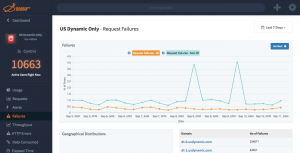Nowadays, more and more businesses are placing heavy emphasis on the mobile user and mobile applications for on-the-go or remote employees. Thanks to the advent of smartphones, affordable data plans, and increased network coverage, more individuals are accessing and using the internet than ever before. Go-Globe, a leading international web design and website development company, posted an infographic designed by GO-Gulf called “Things that Happen on Internet Every 60 Seconds” to help showcase what is happening on the internet in 2017 and what users are spending their time pursuing on the internet. The infographic showed that users partake in a number of different channels every sixty seconds: more than 3.8 million searches are performed on Google; more than 350,000 Tweets are sent on Twitter; 120 new accounts are created on LinkedIn, and more. But beyond the social interaction realms and search engines, the infographic showed that more than 500,000 apps are downloaded every sixty seconds. It certainly speaks to the activity of mobile users and the mass appeal of mobile applications.
In today’s technology-driven world, apps are more than just simple utilities or social networks on mobile devices- They serve as important business tools, too. This is why a number of telecom, VoIP, and conferencing companies have been putting a lot of focus on their mobile application investments. But beyond the features and popularity, what is important in an app to garner an active user base? One very important consideration in app development is an easy-to-use user experience (UX), because this defines how a user will use and interact with the functionalities (and how fluidly they will achieve them). A good UX will not only be easy to use but will also help deliver value to the customer. The more user-friendly the layout is, the greater the chances that users will download, use, and share the app. It’s one of the best ways to earn brand loyalty from users.
App development and app performance have grown as the mobile world continues to explode at an exponential rate. Now, an app developer only needs to write simple code bases for iOS and Android devices. In the early days of mobile, there were differences in the screens and device functionality, too; but eventually, these issues were addressed as mobile pressed on and gained more staying power. But one powerful yet often overlooked issue still remains: the network.
When apps are created and released through app stores, it moves from a testing phase into WiFi and additional network environments; and thus, there are factors that can affect its delivery. SourceForge talked to PacketZoom CEO Shlomi Gian to see how Packetzoom helps tackle app performance roadblocks and finds ways to eliminate these showstoppers.
How Network Discontinuities Can Affect the User Experience
The driving force behind PacketZoom is their overarching goal to eliminate the roadblocks of mobile content delivery. PacketZoom illustrates the average number of disconnections experienced by end users of mobile apps over cellular and WiFi networks, and the metrics are quite staggering (the data reflected in the metrics were obtained using PacketZoom’s technology designed to rescue broken sessions resulting from network discontinuities).

The metric shows the average disconnections that users experience using mobile apps over networks in different countries.
These disconnections disrupt the end user experience and create an overall negative user experience. These disconnects can happen due to different factors such as driving where edifices can block signals or when the user shifts from one network type to another.
In order to meet this demand, PacketZoom’s cloud service creates PZ Expresslanes, which is customized for each app user through WiFi or cellular networks.
How Packetzoom Helps Mobile Developers
“The vision of PacketZoom is to make sure that any mobile application is working perfectly on all networks and in all locations without changing the code,” shared Gian. To achieve this, the company spent three years developing a unique protocol that replaces Transmission Control Protocol, or TCP. As defined by Techopedia, TCP is “a transport layer protocol in the OSI layer and is used to create a connection between remote computers by transporting and ensuring the delivery of messages over supporting networks and the Internet.” Essentially, TCP maintains the exchange of data between network connections. But now, companies are finding alternative methods (and protocols) in order to create more efficient connections.
According to Gian, PacketZoom believes that TCP has severe limitations in regards to mobile because it was initially designed for browsers and desktops (and not for mobile or mobile apps).

PacketZoom CEO Shlomi Gian
Furthermore, they believe that TCP is not able to handle the deficiencies that come with mobility such as latency of the network, constant switching of WiFi, high numbers of lost packets, loss of IP address due to dead zones, and many others. So instead, they offer the PacketZoom protocol.
“PacketZoom Mobile Expresslane is the way to download content 2-3 times faster, have faster and more reliable API access and eliminate network errors and disconnects,” said Gian. “This is at the core of what we do.”
Though not specifically focused on any one industry, PacketZoom has seen success with their solution in four different verticals:
- Gaming – companies oftentimes come to us with the issue of “high abandon rate,” where users make it as far as the download section but then drop off due to any number of factors (which costs companies quite a bit of money). Additionally, companies often suffer due to third-party APIs; and so they use PacketZoom to accelerate their response time from APIs.
- Retail – the goal is to have customers more engaged with the application (hit more product searches, view more images, etc.), and PacketZoom can bring higher speeds and better connections to these applications.
- News – the goal is page views with news applications; and by using PacketZoom, news applications can see a significant increase in pageviews.
- Travel – companies care about more searches and more bookings, and PacketZoom can decrease load time to keep customers more engaged.
Ultimately, PacketZoom’s goal is to increase user engagement, help obtain more reliable APIs, bring a richer user experience to the application, and deliver faster downloads regardless of the application or vertical.
PacketZoom’s Foundation: Mobile Expresslane
PacketZoom Mobile Expresslane is a software-defined solution that removes roadblocks in the last mobile mile. Through this solution, app performance is dramatically increased with up to 3 times the speedup and up to 90 percent of sessions that are rescued from TCP connection drop. Plus, Content Delivery Network (CDN) cost is also reduced through the use of Mobile Expresslane.
Mobile Expresslane includes five key components:
- Throughput Optimization – this makes better transport layer decisions compared to the default way web protocols that operate over mobile networks.
- Session Assurance – controls both ends of the wireless communication from the device so that developers can handle and minimize session interruptions.
- In-app and edge-server caches – capable of reducing round trips to the CDN and origin servers for faster content delivery.
- Global Network Knowledge Engine – stores the “last mile” information about the performance, which helps save time by eliminating slow starts and requests for reconnections and retransmits.
- Fail Forward – a feature that offers a robust layer of protection for customer data and user experience.
PacketZoom Mobile Expresslane also offers these services: network analytics and monitoring, static content acceleration, API acceleration, 3rd party SDK acceleration, and ads acceleration.
PacketZoom Launches Free Analytics Tool Mobile IQ
This month, PacketZoom introduced Mobile IQ, a developer-oriented tool that is integrated with Mobile Expresslane to offer a complete, end-to-end product suite for mobile app performance management and optimization.
Mobile IQ is a free mobile analytics tool that enables app developers to perform several tasks, such as analyze, troubleshoot, and control the performance of apps in real-time. It works by integrating a Software Development Kit (SDK) into the app. Upon starting the application, Mobile IQ analyzes the app in real-time to provide insights on usage, response time, error rates, and other data through a database. Administrators can assess different data sets including the total number active users, total usage, overall performance, geography, networks, and network types. They can also set notification limits to certain odd behavior detected in the application.

Sample analytics of Mobile IQ.
Additionally, developers can set up time connections, http limits, concurrent threads, etc. Gian also divulged that the developers can even prioritize domains and requests from applications for some devices or screens according to needs.
According to Gian, a successful app should be fast regardless of the network it is using or the geographic location of the user. For applications not behaving perfectly in a select location, the PacketZoom protocol in the same SDK can be used to increase speed and response time. “For instance, you can define a rule that says for these assets (images, APIs, etc.) I want to get all of the requests going to a certain domain (whether yours or a third party),” said Gian. “And you can get these through Mobile Expresslane when using our protocol.”
And the good news? PacketZoom is offering Mobile IQ for free. “Our plan is to offer Mobile IQ for free, for life,” added Gian. As a way to stay in line with the company’s vision of “data liberation”, Gian stated that Mobile IQ is their way of helping developers to get easy access to solutions instead of being forced to pay. Oftentimes, in the developer market, what was once offered as a free version becomes available only at a cost
“Through us and by using Mobile IQ, teams can get alerts on the network level to help manage application tools; and lastly, if customers are still not happy and are ready to try something new, we offer them the Mobile Expresslane protocol,” Gian shared.
PacketZoom’s Mission Moving Forward
Applications should make use of third party services that help them deliver fewer network errors and create faster response times. It is also important to give developers a chance to find a golden line between app performance and the user experience. PacketZoom helps developers obtain more reliable APIs to bring rich user experience and deliver faster downloads.
Looking ahead, PacketZoom continues to strive to meet the needs of delivering fast, responsive applications and believes that the next forefront will be video ads. The company also sees augmented reality as a rising trend in the mobile market, and believe that it is an area where PacketZoom could greatly help.
Above all, the company wants to make sure developers do not break the bank trying to sustain their apps. “Until they become successful, these smaller developers are just paying too much,” Gian said. “We want to be able to offer better pricing to smaller developers with free analytics, free alerts, and a better protocol option to give back to these mobile developers.”
Developers who wish to join PacketZoom’s Mobile IQ’s beta program can register on PacketZoom’s website.
About PacketZoom
PacketZoom improves mobile app engagement through in-app networking technology. The mobile platform allows developers to analyze, control, and optimize app performance in real-time, with up to 3x mobile app speed up and up to 90% disconnect rescue. Founded in 2013 by Chetan Ahuja, the company is determined to do what most big companies weren’t able to do – come up with great solutions to boost mobile app performance.
